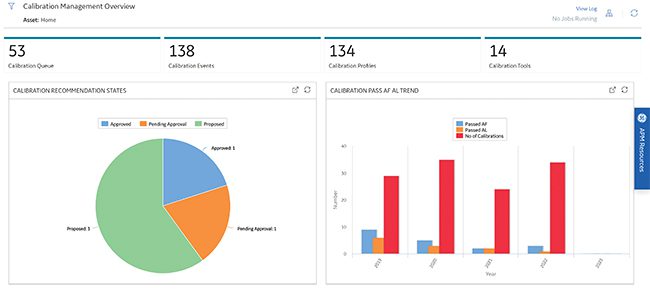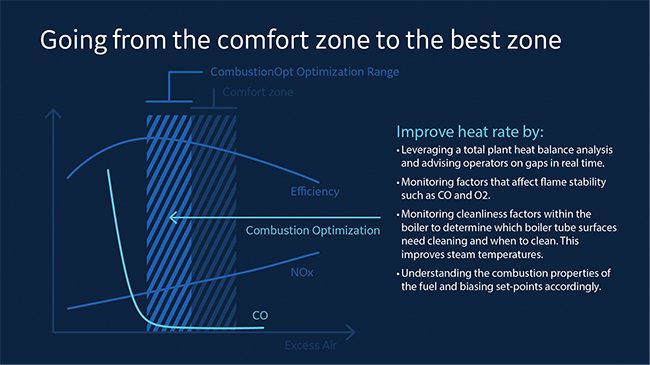Instrumentation and Control for Reliability, Efficiency, and Pollution Control
High-tech instrumentation and state-of-the-art modeling tools are helping power plant operators achieve best-in-class performance, meet pollution targets, and better predict failures. Calibration management software, advanced pattern recognition techniques, and autonomous tuning systems are important pieces of an effective enterprise asset management solution.
Instrumentation matters in today’s power plants because it provides insight to operations and performance of assets in real time. Real-time data and historical data can be used to predict issues ahead of failures or before performance problems arise.
Newer plants typically have more sensors allowing better insight to asset operations. Plants that are aging typically have minimal instrumentation on the key assets. Regardless of which scenario a plant is in, most plants do not have large budgets to continually add more instrumentation. Additionally, keeping up with instrumentation availability and calibrations also can be labor intensive and expensive.
Getting the most out of existing instrumentation is key to plant reliability, performance, and operations and maintenance (O&M) spend. Additionally, using software tools to understand the differences between instrumentation and calibration issues is also important. Having software specific to track calibrations can better organize and standardize calibration activities between technicians and keep a well-documented history.
Documentation of Calibration of Instrumentation for Assets
Instrumentation and sensor data are what feed any remote monitoring software. When using advanced pattern recognition (APR), the data coming in is utilized for models to be able to predict failures. Empirical models can detect small discrepancies in data before a digital control system (DCS) may alarm. This is how it is possible to detect asset issues prior to the problems becoming a failure. By the time a DCS is in alarm, the timeframe to failure is imminent compared to the capabilities of APR, which allows for much earlier prediction, allowing time to make a maintenance plan for the asset.
Managing the calibration of all the instruments that feed APR-type technology is not only labor intensive, but also requires a lot of documentation. Many times, an enterprise asset management (EAM) system is able to track the calibration and preventive maintenance work on instrumentation, but often the documentation does not keep track of the settings and adjustments made to the level of detail needed for technicians who do the calibrations. Often, these details are left to technician notes, notebooks, and manuals, which are rarely all in one place, or not kept at all.
Calibration management for instrumentation and control systems plays an essential role in supporting the efficient operation of the plant. Instrumentation is also a fundamental element in the majority of safety and shutdown systems, so ensuring the reliability and performance of these systems is paramount. Instruments that provide data for predictive models are important to have routine calibration, and documentation of those calibration activities.
Establishing standard work processes for calibration of instruments and DCS systems is a best practice in the industry (Figure 1). Those work processes must have a thorough process of detailed documentation of the calibration steps and outcomes.
 |
|
1. GE’s asset performance management (APM) health calibration management software dashboard. Courtesy: GE Digital |
GE’s asset performance management (APM) health calibration management workflow out-of-the-box configurable graphs include:
- ■ Calibration measurement.
- ■ Calibration error.
- ■ Calibration historical error trend.
- ■ Calibration historical pass/fail trend.
Calibration management helps ensure a standardized approach for lifecycle calibration management is executed, as well as the best practice processes to analyze the effectiveness of calibration strategies. After implementation, instrument technical data can be classified and managed in a standard format, and the overall calibration plan and results can be captured and preserved in a fully auditable format, meeting the compliance requirements of both the Occupational Safety and Health Administration (OSHA) 1910 standard and the International Organization for Standardization (ISO) 9000 series standard. APM calibration management interfaces with EAM systems, allowing for seamless work-process integration between maintenance, operations, engineering, and instrumentation groups.
Neural Networks and Modeling Controls
During the energy transition, focusing on greenhouse gas emissions is even more critical to get the best performance out of your asset. As a power plant operator, there are only so many control screens and systems that can be watched at once.
One way to help with the split decisions necessary to operate the plant is to have neural networks and predictive modeling aiding in fine tuning aspects of heat rate and pollution control systems. With a neural network and specific customized modeling in a closed-loop fashion, operators can focus on other operating issues, while software is optimizing the controls with specific outcomes like heat rate, NOx and CO2. This helps the operator move from operating in a comfort zone to the best zone (Figure 2).
 |
|
2. GE Digital’s neural network optimizers include autonomous tuning and BoilerOpt, which is a boiler combustion software solution. Courtesy: GE Digital |
A digital twin can provide many insights using data, models, and analytics to your asset. For the plant manager, having digital modeling or digital twins of your plant operations can ensure the optimal performance of the plant using the technology available to aid your employees’ operations. This is also helpful for making sure not only is the plant in environmental compliance, but at a compliance rate that optimizes heat rate and pollution limits. For those working at an enterprise level for plant performance and controls, being able to compare plant operations across plants, utilize best practices, and understand poor performers is one way to understand where resources may be needed.
Overview of Instruments and How to Improve Heat Rate and Operator Differences
To exemplify the concepts above, we will look at Autonomous Tuning, a neural network model digital twin of the combustion process in a gas turbine. In this product, this digital twin is used as a method to maintain an up-to-date model of the combustor as operating conditions change. The digital twin is supported by real-time data collected from three sources of instrumentation that already exist in most power plants: the unit controller, the continuous emissions monitoring system (CEMS), and the fuel properties monitor. The digital twin stores real-time data from the data sources and uses it to maintain a machine learning model of the recent operation of the combustor.
Two support modules enable the continuous update of the digital twin’s machine learning model. The first is an exploration module that sends adjustments to the unit controller to explore the space of operation of the combustor, and collect acoustics and emissions data at a wide range of operating conditions. The second is a model training module that uses the data collected with the exploration module to replace the previous machine learning model with a newer one.
In the architecture, a gas turbine digital twin is a software component that is synchronized with the physical object it represents and can support numerous applications. On the top layer of the architecture, we have the applications supported by the digital twin. The digital twin-enabled application is an optimizer that uses a machine learning model of the combustion process in a gas turbine to find optimal adjustments to the turbine’s base schedule that will allow it to operate with reduced acoustics and emissions while improving heat rate, and without the need to manually remap the unit.
The digital twin uses data extracted from various devices and instrumentation in the power plant to maintain an up-to-date machine learning model of combustion, which supports an application that calculates optimal performance adjustments. Unlike manual mapping performed during an outage, exploration to refresh the digital twin is done when the turbine is generating power.
Case Study: GE Aeroderivative LM6000PD Peaking Unit
The neural network model digital twin–based control approach introduced above was evaluated at a peaking combined cycle powered plant. The plant is located in an area where the fuel provider may change the natural gas composition daily, switching between fuels with different lower heating value and specific gravity.
Such a complex scenario had caused issues with high emissions and acoustics over the year prior to the autonomous tuning implementation and had required the invention of remote tuners and field service mappers. Remote tuners were often called to avoid stage down for high acoustics/blow out and to address problems with NO x (at baseload operations) and CO (at low loads) emissions that were at the upper end of the allowed values. There were also issues with operability risks and high emissions in addition to the fall and spring mapping events that were originally scheduled.
The digital twin–enabled optimizer demonstrated its capability to adapt to changes in ambient temperature and fuel properties. The gas turbine operated for a space of one year without the need for tuning services or remapping events. The optimizer was able to drive the combustor to acceptable conditions without the need for human intervention. Digital twins can enhance decision making in power generation by leveraging real-time sensors to maintain an up to-date model of the operation of power generation equipment, and allowing engineers to track the evolution of its operating conditions.
Helpful Tools Are Available Now
Using digital twins with instrumentation and modeling of assets is how companies are going to be better at predicting failures, achieving best performance, and meeting pollution targets. Utilizing software for calibration management and advanced pattern recognition helps plant managers predict asset failures prior to the failure occurring. In addition, utilizing the closed-loop controls systems, such as autonomous tuning, is an effective way to help with inconsistencies in operations and asset performance in regards to efficiency and pollution controls.
—Jenny Bulach is an Energy Industrial Principal with GE Digital, and Martha Saker is Principal Product Manager with GE Digital.